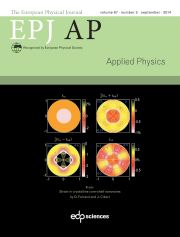Article contents
Definition of a simple resolution criterion in an Apertureless Scanning Near-Field OpticalMicroscope (A-SNOM): contribution of the tip vibration and lock-indetection
Published online by Cambridge University Press: 22 March 2004
Abstract
A realistic near-field calculation on metallic hole samples in illumination transmission conditions predicts certain light confinements around the holes. The purpose of this paper is to explain theoretically how an A-SNOM (Apertureless Scanning Near-field Optical Microscope) is able to detect the light confinement around the holes, and how it is possible, by defining a criterion of separation between two holes in near-field, to analyse the resolution as a function of the experimental parameters. The modulation of the probe height in A-SNOM is used for both distance control and separation of the near-field from the background scattered light. A realistic model of lock-in detection is used to calculate the images of test samples. Constant height mode images are presented at different amplitudes of probe modulation and average heights of the tip. We also discuss the detection at different demodulation harmonics.
- Type
- Research Article
- Information
- Copyright
- © EDP Sciences, 2004
References
- 7
- Cited by


